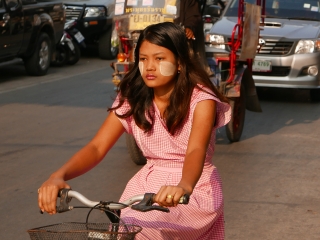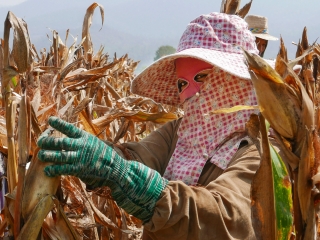“Songthaew” is a word I couldn’t once say right during my two months in Thailand. The first syllable, ‘song’, was intuitive and at the same time suggestive of the second part, ‘thaew’, a tonal roller-coaster with far more vowels than one might think. It is a vital word to know in certain areas in Northern Thailand, where this repurposed pickup truck with two plain benches covered by a tarp is the only means of public transport to more remote places. I permanently gave up on my attempts to pronounce it right while waiting for a songthaew to Umphang, an end-of-the-road village on the Burmese border, surrounded by thick jungle. Two Thai ladies at the bus stop patiently uttered the word in slow motion again and again at my request, and I tried hard to reproduce what my farang ear had understood, with increasing laughter from the audience and sadly without any success. At least I got the songthaew etiquette right: driver is boss; the car will not depart until it is full; never sit next to a monk; squeezing is an art, practice it; wear a jacket, because you are exposed to strong draft; when you want to get off, bang on the floor loudly with your feet; carry a plastic bag, especially on winding roads.
I usually carried motion sickness medication instead. Most of the roads in Northern Thailand come with a warning of motion sickness since they straddle high mountains and steep river valleys. Yet after a couple of rides under the protective effect of the pills, my conclusion was that some drug company had just thought up another use for sleeping pills. No wonder I forgot all about my nausea if I was almost knocked out, struggling to keep my eyelids from sliding down. However, in the frantic environment of a songthaew it was best to stay awake, so I decided to do the trip to Umphang without the pills. I researched little before departing from Mae Sot, but enough to know that this would be another high-altitude road with curves. The recent journeys hadn’t been as bad as predicted anyway, so I just had a light breakfast and plucked up some courage.
We left Mae Sot with a sold out songthaew: hill tribe women who were chatting nonstop, some teenage girls, a catatonic old man, an old couple with their granddaughter, and, right next to me, a man with a bottle of liquor, which he was pouring, like a gentleman, into a plastic cup before drinking. He did so unflinchingly at regular intervals. His ritual was all the more surprising as Thais are quite reserved when it comes to drinking in public and even the shops sell liquor only during certain hours.
The first 50 kilometers were a breeze, quite literally, and I delighted in the change of temperature and in the nearly straight road flanked by villages and all sorts of agricultural activities. 110 kilometers left, an easy journey. Then we started our ascent into an area with evergreen forest and the first serious twists appeared. I clutched the iron bar on the songthaew’s roof and felt safely anchored by my fellow passengers as we sat there crammed. A young couple with sacks who had boarded a few kilometers back had been less lucky and had to stand on a small platform at the truck’s back, their lives depending on how tight they could hold. People kept on chatting, the man with the bottle poured himself another drink, signs of normalcy that reassured me about the road ahead.
A sudden change of air signaled that we had reached higher grounds. The area seemed completely untouched and the jungle was bending over the road, threatening to engulf it. The road in response became more winding. The driver in response did nothing to slow down. Here and there on the asphalt were lost shoes or scarves, signs that others too had driven hastily, without looking back. A ball of led started to grow inside my stomach and I felt the ominous motion-sickness sweat, but I was determined to push through. A little hole in the tarp, just above the driver’s cabin, became my entire world from that moment on, since by looking through it I could anticipate the curves and feel better. Another hole right next to me would have been more effective, but the man with the bottle had already claimed it, probably for a similar purpose.
The truck gradually grew silent and some of the passengers fell asleep. The loud humming of the cicadas covered the engine’s noise. Each turn provided the setting of a suspense film (drowsy people, zero visibility, thick jungle, diminished light, a bit of mist), but the plot wasn’t much of a surprise: more turns, more jungle. After a while, we were bouncing from one hairpin bend to another, and my little hole in the tarp was not offering enough perspective. I had to lean forward and backward to the rhythm of the bends to fool my body, and my agitation must have displeased the man with the bottle, who turned his back definitively. The teenage girls opposite me were sleeping on each other’s shoulders and formed a three-person blob that did a synchronous dance with each sudden move of the car. The strong draft was slowly blowing off the cap of one of the girls, and I woke her up to warn her, but it flew away before she even realized. She just shrugged her shoulders to me and went back to sleep.
The couple with sacks got off at a forest trail that probably led to a village. We overtook a few hill tribe men carrying superhuman loads of wood and herbs on their backs and I tried to figure out how long they still had to walk, but there were no signs of settlements for a while. It was around this part that the little girl riding with us began to throw up. Her grandma was taking care of her, but without much compassion, as if this was part of life, an initiation, something she herself had experienced, and which the girl would have to get used to eventually. The lack of reaction from the other passengers confirmed that everyone had been there.

As it always happens in a situation of discomfort, time seemed to halt to a standstill. I self-pityingly thought I was living my personal version of limbo: an endless road with very sharp turns and no choice to move. At some point, only I and the man with the bottle were still awake, each of us in a warped dimension connected to reality by a vital hole in the tarp. However, with each kilometer my fight with motion-sickness had one less hurdle, and a dramatic change of scenery gave me a decisive jolt of energy. We had reached the ridge and one side of the road overlooked a steep breathtaking valley, with miniature houses on the opposite slope.
This stretch was exhilarating as much as it was dangerous; not taking the pills had just about paid off, because I could enjoy the view wide awake. After a good dose of this fantastic landscape, we passed a huge cabbage plantation, followed by a string of hills covered in hundreds of bamboo shacks, seemingly a favela confined to a forsaken mountain top (I later found out this was Umpiem refugee camp, the second largest in Thailand).
At last, we left the steep slopes behind and entered a hilly region where the forest gave in to agricultural land. Villages popped up here and there and the passengers asked for frequent stops. Each time a local got off the songthaew, an argument would start with the driver regarding the price. One time, a passenger’s whole family was summoned from the village to help in the conflict. Another time, the driver confiscated a man’s sack to make him pay. I watched closely, trying to figure out who is ripping off whom, but it was hard to take sides.
By the time we reached Umphang, I was the only one left in the car. The driver stopped in the center of the village and asked me politely to pay the fair price of the ride. I got off the songthaew victorious but completely drained after the 4 1/2-hour trip and set off to scout the place.
Across the street, a souvenir shop was selling neon colored T-shirts with a revelatory summary of the entire journey: “I’ve survived Road No. 1090 aka Death Highway with 1219 curves in Umphang, Tak, Thailand.”





Leave a Reply